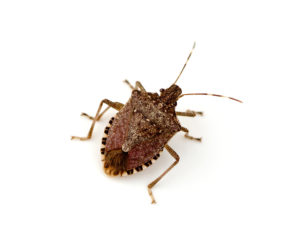Stink Bug Service in Marion, Mount Gilead, Delaware, OH, and Surrounding Areas
Originally found in East Asia, stink bugs were not even reported in the United States until the late 1990’s! They get their name from an unpleasant odor released when you crush them or when they are protecting their homes.
 What do Stink bugs look like?
What do Stink bugs look like?
Stink bugs are described in several different ways. They are characterized as both “large, oval-shaped insects” and “shield-shaped insects.” Adult stink bugs can reach almost 2 cm in length. They are nearly as wide as they are long. Their legs extend from the sides, so this makes the adult bugs appear even larger. The brown marmorated stink bug is a brownish stink bug. It has lighter bands on the antennae and darker bands on the wings.
Adult stink-bugs are good fliers and fold their wings on top of their body when they land. Nymphs do not have fully developed wings. The wings appear when the nymph becomes an adult. Fully developed wings are a way to identify adult stink bugs.
Immature stink bus, called nymphs, are very tiny when they hatch from their eggs. Nymphs of the brown marmorated stink bug are yellow and red. As they grow, the yellow fades to white. They have bright red eyes during the nymph stage of their life cycle. The nymphs molt or shed their skin five times. Each time a stink bug nymph molts, it becomes larger. By the last molt, the nymphs are almost as large as adult stink bugs.
Habits:
In general, adult stink bugs feed on fruits and nymphs feed on leaves, stems and fruit. The life cycle of brown marmorated stink bugs generally involves mating., reproducing and feeding from spring to late fall. Upon the onset of cold weather, stink bugs seek shelter to spend the winter in a dormant phase known as diapause.
Stink bugs search for overwintering sites in the late fall before the weather conditions drastically change. They spend the winter hiding inside homes or buildings, usually in the walls, attic or crawl space. However, entering into diapause may not be the complete end to their season of activity. If the weather warms up for a long enough period of time, indoor overwintering stink bugs might be misled into thinking it is time to exit their diapause period and become active again. Stink bugs reemerge in early spring and become active. They are trying to exit structures, but sometimes they enter our living spaces instead.
Brown marmorated stink bugs mate and create up to 3 generations per year depending on their habitat. Cooler zones see one generation per year, while warmer areas are likely to see 2-3. Female stink bugs typically lay 20 to 30 eggs. Egg laying generally occurs from May through August. The eggs are light green, barrel-shaped, and are attached side-by-side on the underside of the host plant’s leaves in a mass. Eggs hatch four to five days later and the nymph will begin to fee. They undergo a series of molts until they become adults by fall.
The brown marmorated stink bug cannot sting and is not likely to bite. The stink bug’s mouthparts are grouped in the piercing/sucking category, but they do not use blood as a food source like mosquitoes, biting flies and bed bugs. Their mouths are not structured in a way that enable them to bite through human skin. Most species of stink bugs feed on plants. They suck the juice from leaves, stems and roots of plants. They attack everything from ornamental plants to weeds. The insects pierce the skin of the plant and extract the juice inside.
Threats:
Although these smelly pests do not pose serious property or safety threats to homeowners, their tendency to invade homes in high numbers can be a nuisance. Stink bugs can damage ornamental plants, fruit trees, and gardens, but again they are more of a nuisance than a threat to people.
The U.S. Department of Agriculture warns that stink bugs have the potential to spread throughout the country, which could be harmful to the agricultural industry, as they destroy crops.
NPMA offers the following tips: (National Pest Management Association)
- Seal cracks around windows, doors, electrical outlets, ceiling fans and light switches
- Replace outdoor lighting with yellow bulbs, which are less attractive to stink bugs.
- Repair damaged window screens. Also screen attic and crawlspace vents (if you have crawl space vents)
- Use a vacuum to eliminate stink bugs indoors. Seal vacuum’s contents in a plastic bag and dispose of it immediately.
- If an infestation develops, contact a professional promptly.
